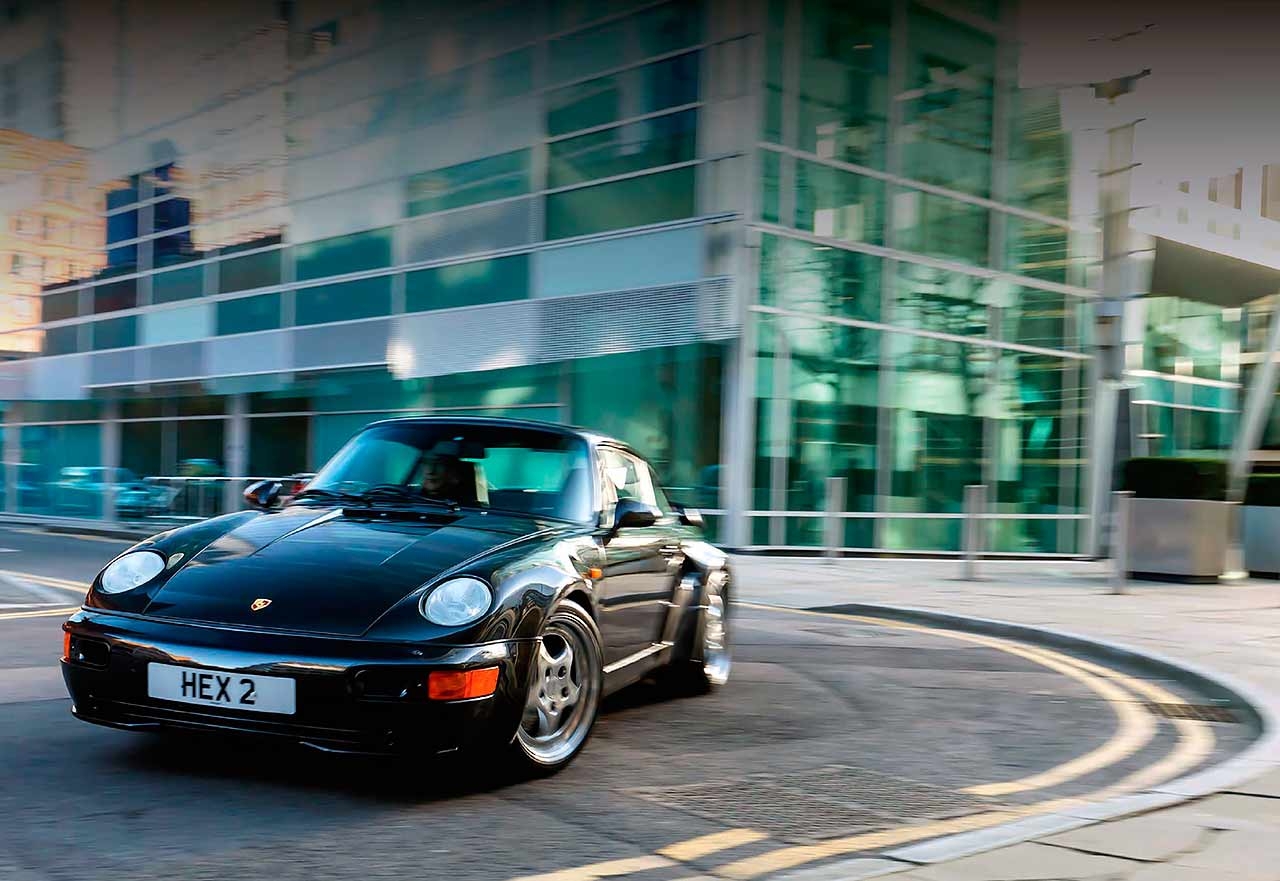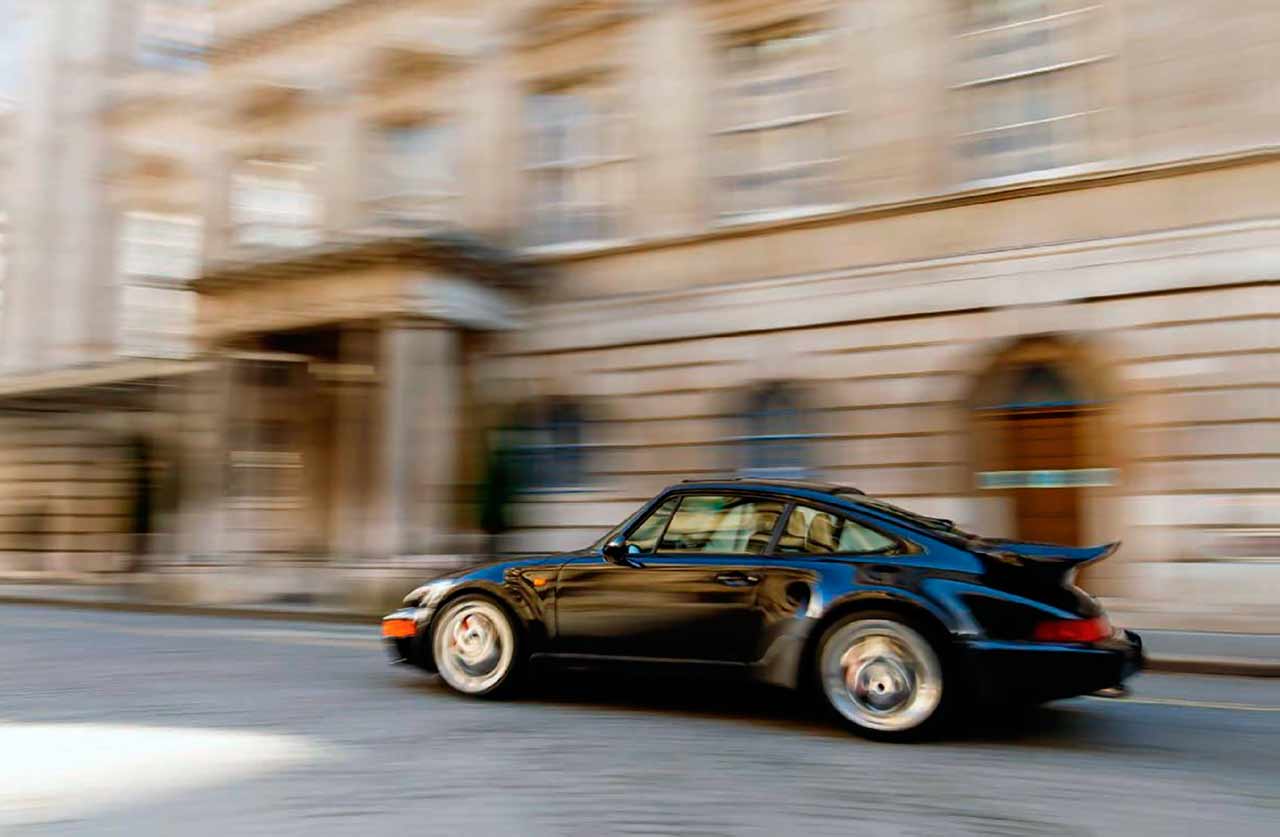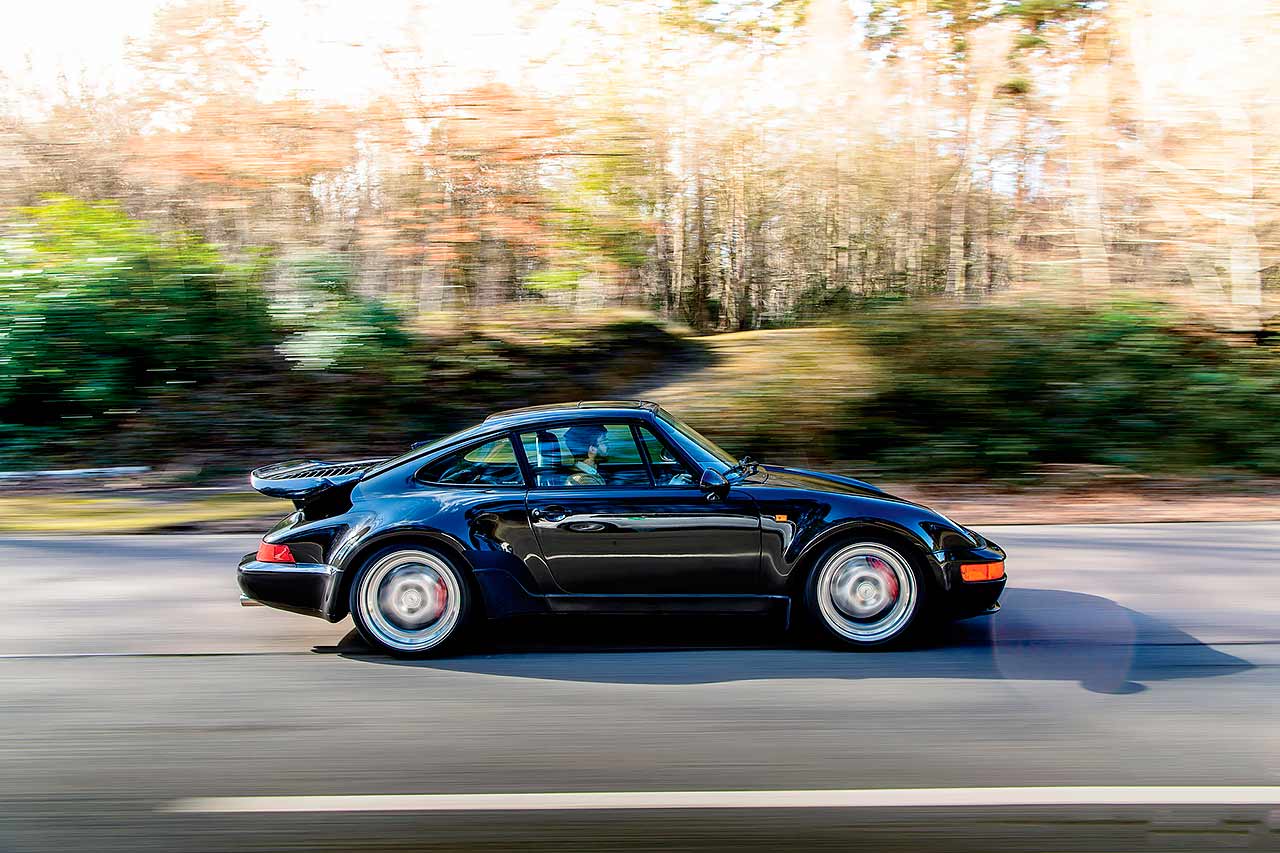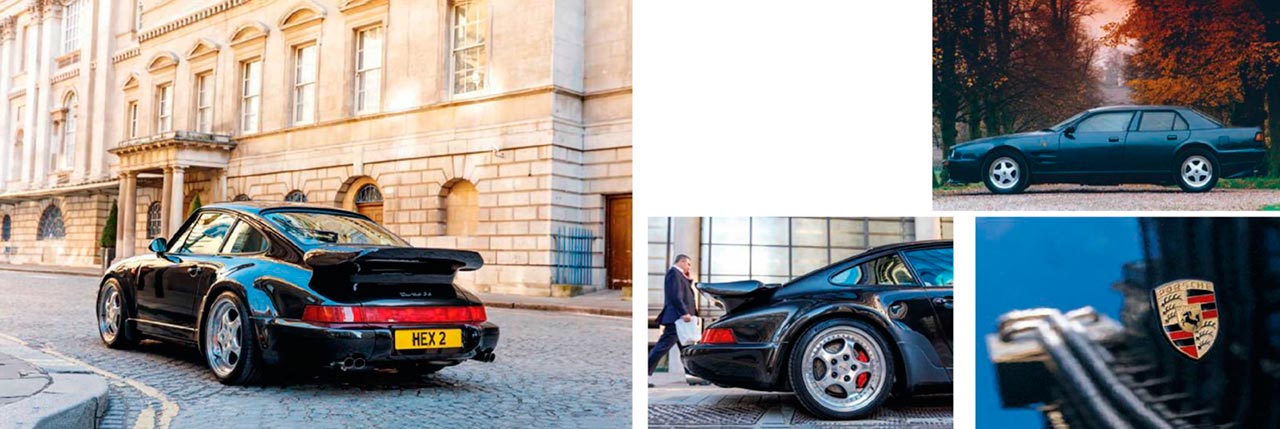
Stuttgart’s enigma machine. Limited-edition 911. Ex-Sultan of Brunei 964 ‘flatnose’ Built by the factory in tiny numbers, the 964 Flatnose was the ultimate bespoke Porsche, says Richard Heseltine as he samples one of the world’s least-publicised special editions. Photography David Shepherd.
Sultan of Brunei’s 911 Ultra-rare 964 3.6 Turbo ‘flatnose’
The silence that follows is swollen and barbed. Perhaps something was lost in the translation. The problem may just as easily have been rooted in the pronunciation – Flachbau doesn’t roll off the tongue if you have a tin ear for languages, and probably came across as an expletive. Whatever the truth, our new friend refuses to believe that this Porsche left the factory as it currently appears. He likes the car, loves it in fact, but wants to know if it has been customised. Answering “yes and no” doesn’t seem to cut it. He just stares, shooting a look that reads: ‘Are you really as stupid as I think you are?’

This, by itself, is not a new phenomenon, but in this particular instance his incredulity is explicable. You see, this ultra-rare variant of Porsche wasn’t actively promoted in period, if at all. Yes, it was a production model, and yes it was customised.
It’s just that ‘production’ and ‘customised’ are relative terms. It was built by Porsche, but inside its skunkworks (now known as the Exclusive division). What’s more, most of its kind were sold before the ink on the press release was dry.
And by ‘press release’, we mean a memo was sent out to the dealer network. Even London’s City Boys who had vacuumed up the previous generation of Flatnoses in the late ’80s would have encountered problems landing one – had they ever been aware of its existence to begin with.
Scroll back to 1993, and a standard 964 turbo would have set you back the thick end of £130,000, but a car built to the specification seen here would have been almost double that figure. Plus, in order to bag one, it helped if you had a title somewhere in your name. This particular example was first owned by the Sultan of Brunei, no less. Even then, there were differences in look and specification. This was, depending on whose sources you credit, the last truly hand-finished Porsche.
In order to understand its place in marque lore, first you need to appreciate just how radical a departure the regular 964 was over the preceding 911. All told, it carried over only 13% of its ancestry from the outgoing model. Introduced in Carrera 4 form in January 1989, the 964 was a technical tour de force, sharing at least a modicum of DNA with the ultra-complex 959/961. It was no ordinary 911, that’s for sure.

For starters, it featured four-wheel drive and dispensed with the torsion-bar suspension arrangements of old, replacing them with MacPherson struts and semi-trailing arms. Okay, so it didn’t have the Group B weapon’s multidimensional electronics and torque-dividing doodahs, but it was packing vast levels of grip and Bosch ABS derived from the 928 S4 set-up. There was even power steering. This was the revelatory replacing the rote, where jibes about 911s going arse-ways into ditches suddenly became a thing of the past. There would be no more dallying with the Grim Reaper, even if pilots couldn’t differentiate between braking and turning. As if that wasn’t enough, the 3.6-litre air-cooled flat-six packed 250bhp in standard form.
Then there was the outer wrapper that – save the roof, some side panels and the bonnet – shared little in common with the previous iteration. Up front, it featured a new integrated bumper/spoiler combo with cooling ducts and driving lights. At the rear, there were wraparound lights and a retractable electric spoiler that deployed at speeds above 50mph and sat flush with the engine cover the rest of the time. The car had an altogether smoother, softer look than we had become accustomed to. Not only that, an endless array of variations on the theme followed in rapid-fire succession.
In October ’1989, Porsche began offering the rear-wheel-drive Carrera 2 in Coupé, targa and Cabriolet configurations. In January 1990, Tiptronic semi-automatic transmission became available, while two months later the firm ushered in the steroidal 3.3-litre turbo (which featured the ‘930’ engine). Just to add confusion, turbo-look styling became available as an option on the Carrera 2 Coupé and Cabriolet models from August ’1991, not forgetting the Speedster variant that was launched in February 1993. Or the turbo for that matter, which received the 3.6-litre ‘M64’ engine in time for its relaunch in October ’1992. And then there was the turbo S, the endlessly entertaining Carrera RS and the jaw-slackening, eye-widening Carrera RS 3.8, as well as… Well, you get the idea.
It seemed as if a week didn’t go by without another permutation coming online as another one disappeared, some limited-edition models making like the mayfly almost as quickly as they had arrived. The mix-and-match approach may have been easily comprehensible to the marque faithful, but it was baffling to the uninitiated. The only slight problem for Porsche was that both camps proved largely immune to the 964’s charms. All told, the car sold in lesser numbers than the version that bore it, as well as the 993 that followed in its wake from December ’1993.
Given Zuffenhausen’s current prosperity, it’s easy to forget that the picture wasn’t quite so rosy a quarter of a century ago. In fact, it was downright bleak, Porsche’s business model requiring an endless array of siblings to be based on the same basic design. Of course, a lot of rival manufacturers would have killed to be so ‘unsuccessful’.
Some 62,172 were made, the 964 acting as a bridgehead between the ‘classic’ 911s and the high-tech models of the mid-’90s and beyond. What’s more, it spawned one of the most intriguing curios ever to emerge from Weissach in the shape of the car you see here: the 964 Flachbau. As is so often the way with cars of this ilk, a degree of confusion surrounds this ultra-obscure strain, not least because not all Flatnoses had, er, flat noses. Story has it that a memo was sent out in 1993, shortly before the 993 was set to be introduced. A special last-of-the- line edition of the 964 was to be offered on the quiet, but, this being Porsche, there would be four distinct versions based upon the turbo.
Each would boast a raft of physical tweaks in addition to performance upgrades. There would be 10 Japanese-market X83s with old-school pop-up headlights and side strakes, 27 ‘Rest of the World’ X84 versions with exposed 968-style flip-up units, 39 X85 US-market cars with the same lighting arrangement and, just to add to the confusion, America would also receive 17 non-Flatnose ‘Package’ cars, boasting all of the physical changes bar the headlamp treatment.
These body mods stretched to, among other things, a new front spoiler and rear wings with air intakes similar to those of the 959. Some of these parts were made by Tech Art but no two cars were ever truly alike, not least with the cabin treatment. You could specify everything from which speakers you wanted to electric seat adjusters, via a top-tinted windscreen and a whole lot more besides. All told, 51 punters opted for the X88 3.6-litre turbo S engine, as here, with tweaks including reworked heads, modified inlet manifolds, an extra oil cooler and a four-pipe exhaust arrangement.
‘Our’ car was specified with just about everything, which is no great surprise given its first owner. At rest in London’s financial hub, it doesn’t appear out of place 23 years down the line. It looks positively evil in metallic black riding on polished 18in Carrera Cup alloys: there’s no poetic magnificence here, more the comfort of the familiar but with a twist. Unlike the previous-generation Flatnose, the lighting arrangement here doesn’t scream: ‘Look at me!’ It’s almost subtle. You know there’s something different about this car, but it takes a moment to pinpoint exactly what it is. It’s almost as though it was designed this way all along. If anything, it owes styling cues to the stillborn 965.
We certainly picked the right place for the photo-shoot, too. Everyone seems to have a reverent look in their eyes, even if they don’t know quite what they’re seeing. From inside, however, it’s much as you remember: unlike so many other high-horsepower blunt instruments, here you have a relatively lofty seating position and can see every corner of the body. The dashboard and instrument layout remain much as you remember (continuity is a 911 constant, after all), while the leather-clad chairs are supercomfy – embracing without pinching. That said, black on black does make for a toasty cabin, and ventilation is at best adequate. And while central London isn’t the best place for exploiting a car packing 385bhp, you soon appreciate how snug and relatively compact it is in the real world.
Off boost it’s utterly non-threatening. There’s no hair-trigger throttle nonsense here. Prior experience informs you that the turbo doesn’t really kick in much below 4000rpm, and even then the flat-six feels uncannily like a normally aspirated unit in that response is instantaneous and the power delivery linear. Only the noise reminds you that it’s a turbocharged unit. It’s characterful, if not particularly tuneful. And it does move, acceleration being of the ballistic variety (0-60mph in around 4.7 secs). In some cars, fast doesn’t always seem it, because you feel slightly detached from the action. That isn’t the case here.
What’s more, the car rides reasonably well despite the ultra-low profile tyres. It will even traverse sleeping policemen without bottoming out. The gearchange is a bit notchy, although that rather goes with the territory, while the steering is light but positive with it. Even as traffic threatens to set like concrete, you don’t feel particularly perturbed. The clutch isn’t so firm as to plait your hamstrings as you trickle along, nor do you have to suffer through a 100-decibel conversation with your passenger as you struggle to be heard over a grumpy multi-cylinder engine at idle. By the same token, you don’t need to constantly scrutinise the gauges out of fear that it will ‘do a Krakatoa’. It’s a Porsche, after all.
The only thing that intimidates here is the huge price tag. This car has completed only 600 or so miles since new, and is about as close to a brand-new 964 Flachbau as you’re ever likely to find. All too often, small-series ‘specials’ are attractive in their own way, but of no lasting value. In this particular instance, the bespoke tailoring only increases the appeal. A flat-six Porsche with a flat nose: what’s not to like?
Thanks to Paul Michaels: hexagonclassics.com
‘YES, IT’S A PRODUCTION MODEL, AND YES IT WAS CUSTOMISED, BUT SUCH TERMS ARE RELATIVE’
‘UNLIKE THE PREVIOUSGENERATION FLATNOSE, IT DOESN’T SCREAM LOOK AT ME. IT’S SUBTLE’


Collector’s corner
In comparison with some cars owned by Hassanal Bolkiah, aka the Sultan of Brunei, the Flachbau is almost off-the-peg. It’s believed that at one point, the monarch’s collection stretched to more than 7000 vehicles, his fleet including several that purportedly didn’t exist. Think the Ferrari Mythos concept remained unique? Nope, he had three made in secret. Reckon that F40s were only ever sold in left-hand drive? He had seven converted to RHD, each one silver.

And let’s not forget the Ferrari FX series cars tailored by Pininfarina (which also reworked Jaguar XJ220s on his behalf). Then there was the Bentley Java from 1992. Sadly, tragically even, that never made it into production, but the Sultan ordered a few anyway. He also had several Bentley estates converted by Robert Jankel, plus restyled, Bentley-badged (and engined) Range Rovers. Aston Martins included four-door Virage-based Lagondas (above), plus some Vantage V600-based AM3s. His collection also ran to F1 cars and a private test track.





